Table of Contents
One goal of the Bureau of Mines is to conserve the Nation’s mineral resources by developing improved performance materials. Consistent with this goal, the Bureau conducted studies on the formation of undesirable cristobalite in seven different fire clays used as refractories. The studies employed scanning electron micrography, chemical and X-ray analyses, and pyrometric cone equivalent determinations to examine the sample clays and determine the effect of thermal history and stablilizing additives on the amount of cristobalite in various calcines.
This research has indicated that as fire clay calcining temperatures increased from 1,390° to 1,490° C there was a gradual decrease in the percent of cristobalite present in the calcines and a progressive development of mullite crystallization. No cristobalite was found in fire clays calcined above 1,550° C, but cristobalite reappeared when the calcines were reheated to temperatures between 1,400° and 1,500° C. The research also revealed that additions of lithium fluoride (LiF) prevented formation of cristobalite in fire clay calcines.
As part of the Bureau of Mines goal to conserve the Nation’s mineral resources by developing improved performance materials, seven fire clay calcines were evaluated to obtain a better understanding of their performance behavior.
Refractory clay brick production from 1970 through 1975 averaged about 1 million tons per year, or one-fifth of total refractories produced. The largest group of refractory products, both in terms of varieties and share of total market, is the 40- to 46-percent-alumina (Al2O3) class of fire clay refractories covered in this study. Historically, the principal raw materials used for these products were ball clays, fire clays, and flint clays, all predominantly kaolinitic. Although impure sedimentary kaolins have not been generally considered a common raw material because of their high firing shrinkage, dense calcines with excellent refractory aggregate properties are now being marketed from beneficiated kaolins.
Brindley and Nakahira showed that kaolinite decomposes to meta-kaolin upon dehydroxilation around 550° C and, on further heating to between 700° and 900° C, transforms into a cubic spinel type structure by recrystallization. Above 980° C, mullite forms as this spinel-type phase decomposes. (Amorphous silica is progressively freed as the meta-kaolin transforms to the spinel structure, which then transforms to mullite.) Cristobalite is first observed at 1,100° C; it is formed from the amorphous silica by a gradual orientation and relocation of atoms. At temperatures from 1,300° to 1,400° C, cristobalite tends to disappear, while a siliceous glass phase appears and gradually increases.
Konopicky in 1959 and Johnson and Andrews in 1962 reported on the mineralogy of various alumino-silicate refractories. In products having an alumina content ranging from 39 to 45 percent, they found that mullite varied between 43 and 55 percent, cristobalite between 5 and 30 percent, and the glass phase between 12 and 45 percent. They indicated that the mullite content was related to the total alumina content of the raw materials, while the cristobalite and glass percentages depended on the amount of silica and fluxing elements. Refractory clay bricks, particularly if they contain appreciable alkali, were found to contain only mullite, with the remainder made up principally of a siliceous glass.
The varying amounts of cristobalite that can occur in a fire clay calcine, and subsequently in a fire clay refractory during service, are of major concern in metallurgical furnace applications. Cristobalite undergoes a marked volume change when it passes through 212° C, consequently causing spalling or weakening of the refractory. This report presents the results of studies made to trace cristobalite development in seven fire clay calcines as affected by thermal history, with and without the addition of stabilizing agents.
Sample Characterization
The samples used in this investigation were commercial-grade, calcined, kaolinitic materials, commonly termed ‘’grogs.” Six materials were collected, representing the raw clays as well as the calcined materials produced in Alabama, California, Georgia, Missouri, and Pennsylvania. In addition, a high-purity kaolin in the form of a washed commercial clay from Georgia was calcined at the Tuscaloosa Research Center. A representative test sample from each material was ground to pass 325 mesh and used for chemical and X-ray diffraction analyses, and pyrometric cone equivalent (PCE) determinations. Representative test samples ground to about 200 mesh were used to prepare specimens for determining cristobalite formation. Scanning electron microscope (SEM) examinations were made on selected samples of the “as-received” grogs and on fired samples of the raw fire clays.
Chemical Analysis
The compositions of the sample fire clay calcines (grogs) are shown in table 1 in order of decreasing alumina content. The calcines ranged from 44.0 to 47.6 percent alumina, and from 48.2 to 53.0 percent silica (SiO2) and contained varying minor amounts of impurities.

X-ray Analysis
A summary of the X-ray diffraction data for the seven raw clays is given in table 2. The predominant mineral in all samples was kaolinite (Al2Si2O5 (OH)4 ). Gibbsite (Al2O3 .3H2O) was identified in samples 1, 2, and 4; and boehmite (Al2O3·H20) was found in sample 7. Anatase (TiO2) was present in
each clay, and free quartz was present in all but sample 3, the washed kaolin. The clay mineral illite (Ky (Al4 · Fe4Mg4Mg6) Si8-y ·Aly O20 (OH)4 )) was identified in samples 4 and 6.
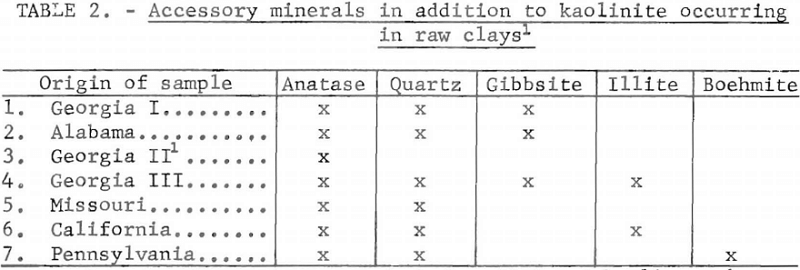
The percent cristobalite in each of the “as-received” grogs is shown in table 3. Mullite and cristobalite were present in all the calcined fire clays.
Cristobalite was quantitatively determined by using the integrated X-ray diffraction peak intensities of the (101) reflection for cristobalite. Standard curves were established from prepared mixtures of cristobalite and mullite. Cristobalite for these mixtures was produced by heating silicic acid (H2SiO2) at 1,650° C for 2 hours; the mullite was obtained commercially.
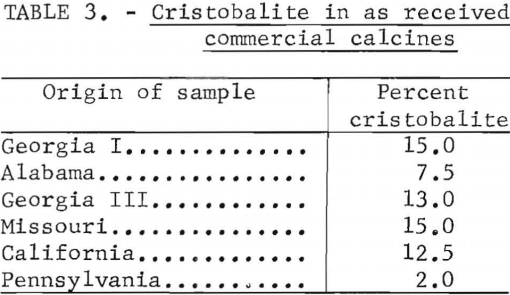
SEM Analysis
Scanning electron micrographs were used to establish the microstructure of the raw clays, the “as-received” calcines, and samples of raw clay fired to 1,390°, 1,440°, 1,490°, 1,540°, and 1,590° C. Figures 1 through 7 are composite SEM’s of each of the raw clays and samples fired to different temperatures. Percentages of cristobalite shown in each illustration were determined by X-ray analysis. In each case, the original hexagonal platelets of kaolinite are apparent in the raw refractory clays, followed by the gradual appearance of mullite crystals in the fired samples. The mullite crystals increase in size and crystallinity as the firing temperature increases. This relationship of heat treatment and mullite development is so characteristic and reproducible that it can be used to determine the temperature to which a fire clay sample has been exposed. In general, the individual needlelike mullite crystals were found to range in size from approximately 0.025 to 1.0 micrometers.
When SEM’s showing individual grains of “as-received” commercial calcines were studied, it was apparent that the grains experienced different heat treatments during the calcination process. Figure 8 shows typical examples of the microstructure observed in individual grains from the same samples of “as-received” calcines. Mullite development in the micrographs of Georgia III calcines indicates that the samples were exposed to heat treatments equivalent to temperatures of about 1,400° and 1,500° C, respectively. Micrograph A of a California calcined grain represents a calcination temperature of about 1,490° C; micrograph B represents a temperature of about 1,540° C. This technique could be used as a quality control tool in the production of commercial “grogs” or to determine the extent of actual heat treatment that fire clay grains undergo during calcination.
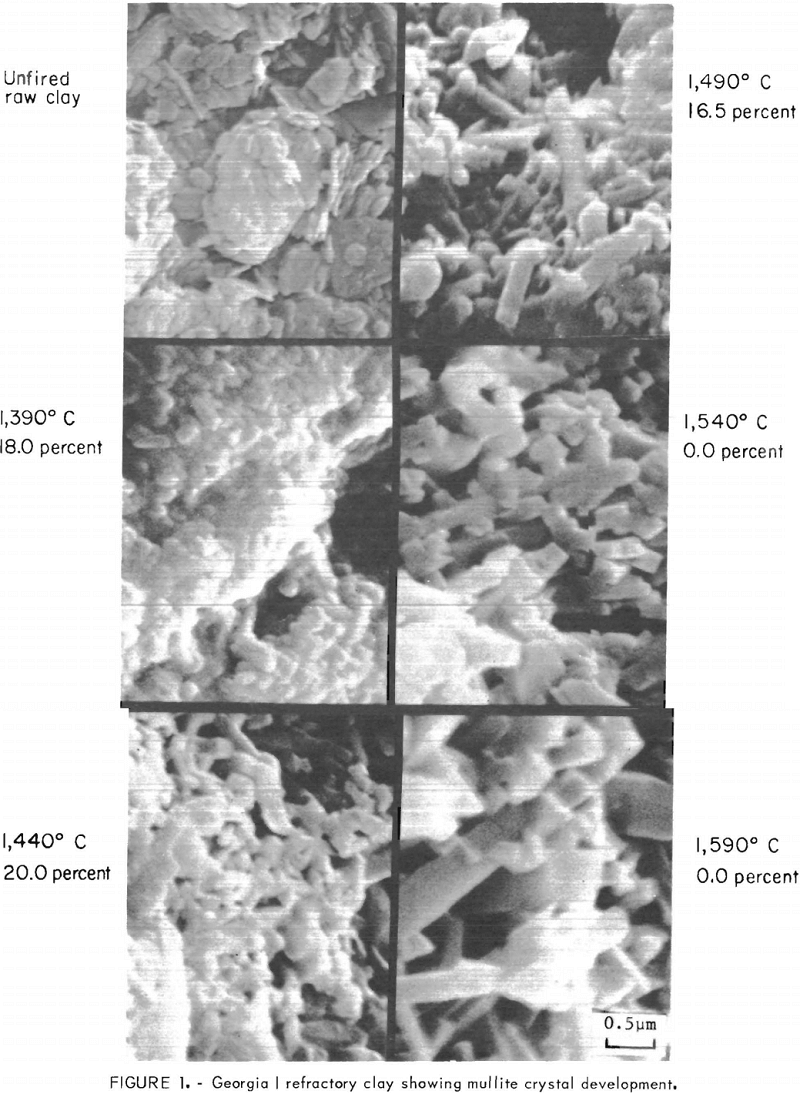
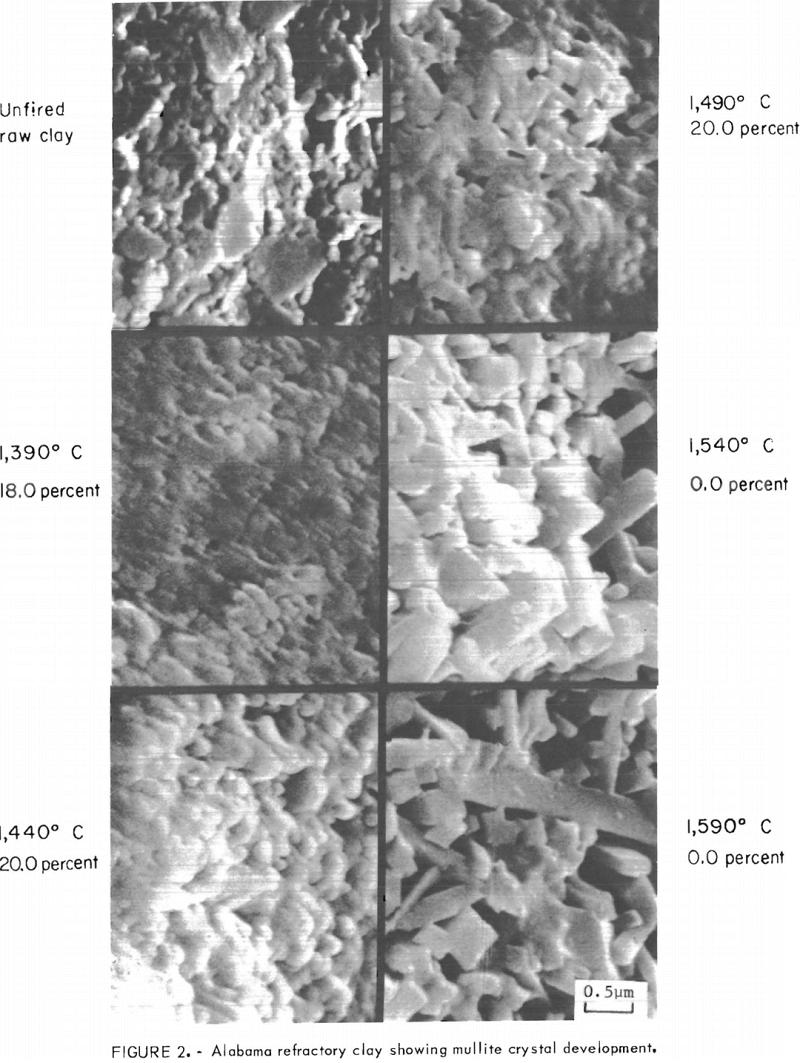
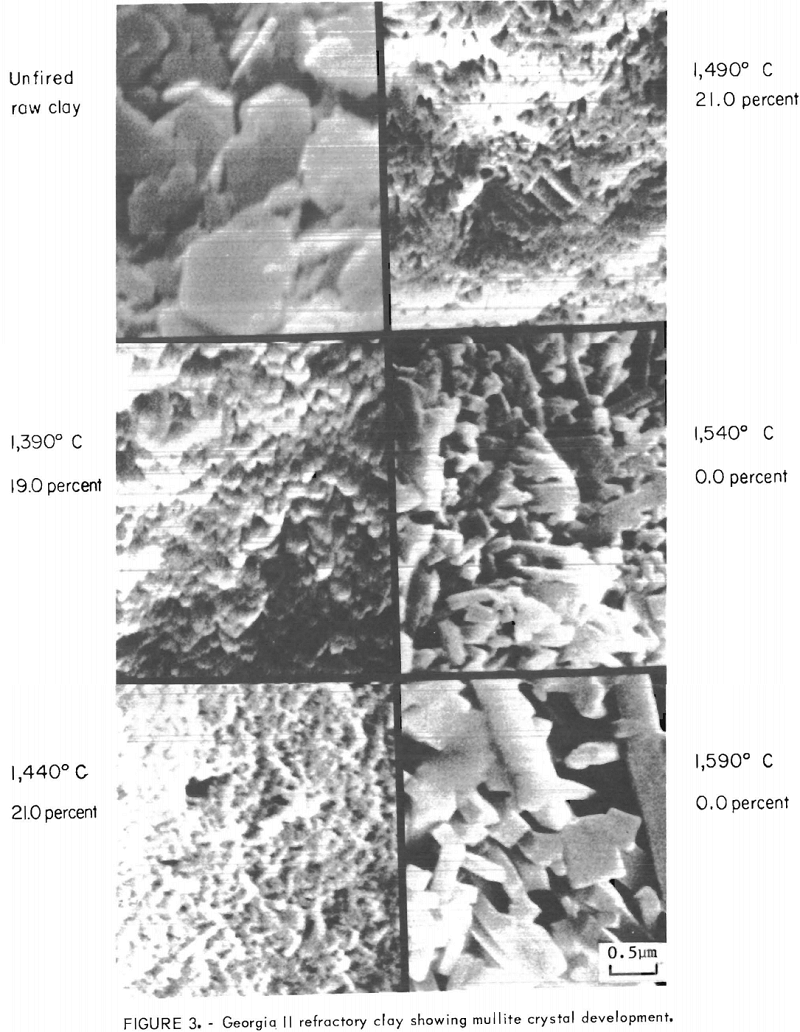
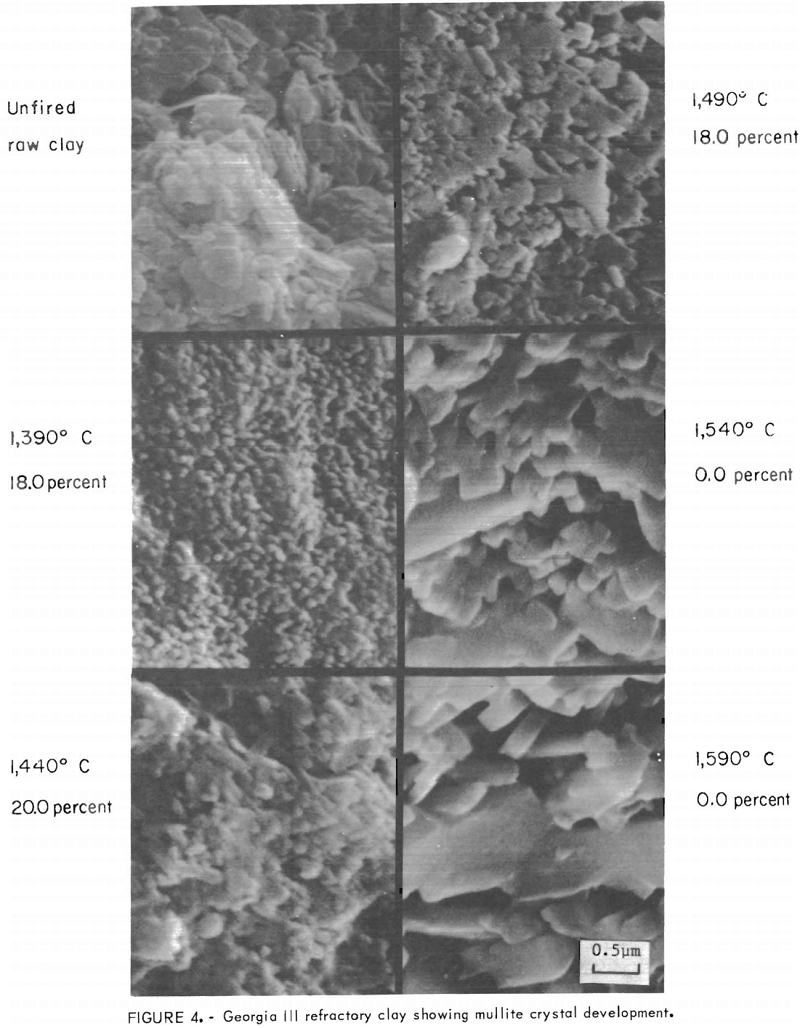
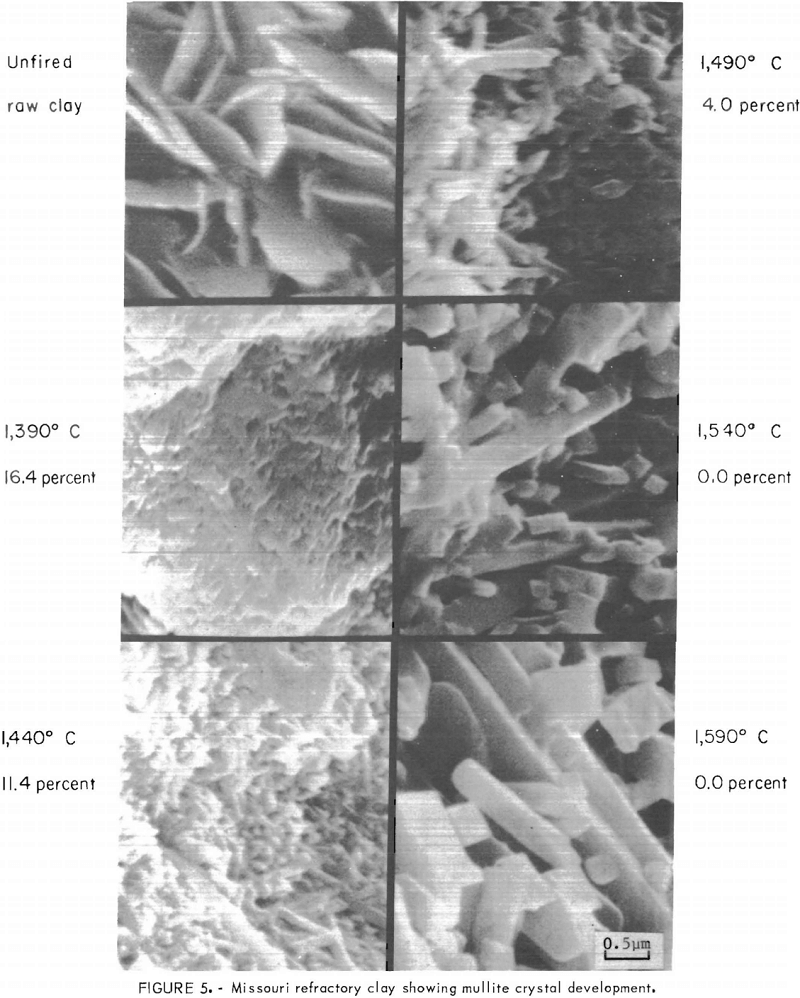
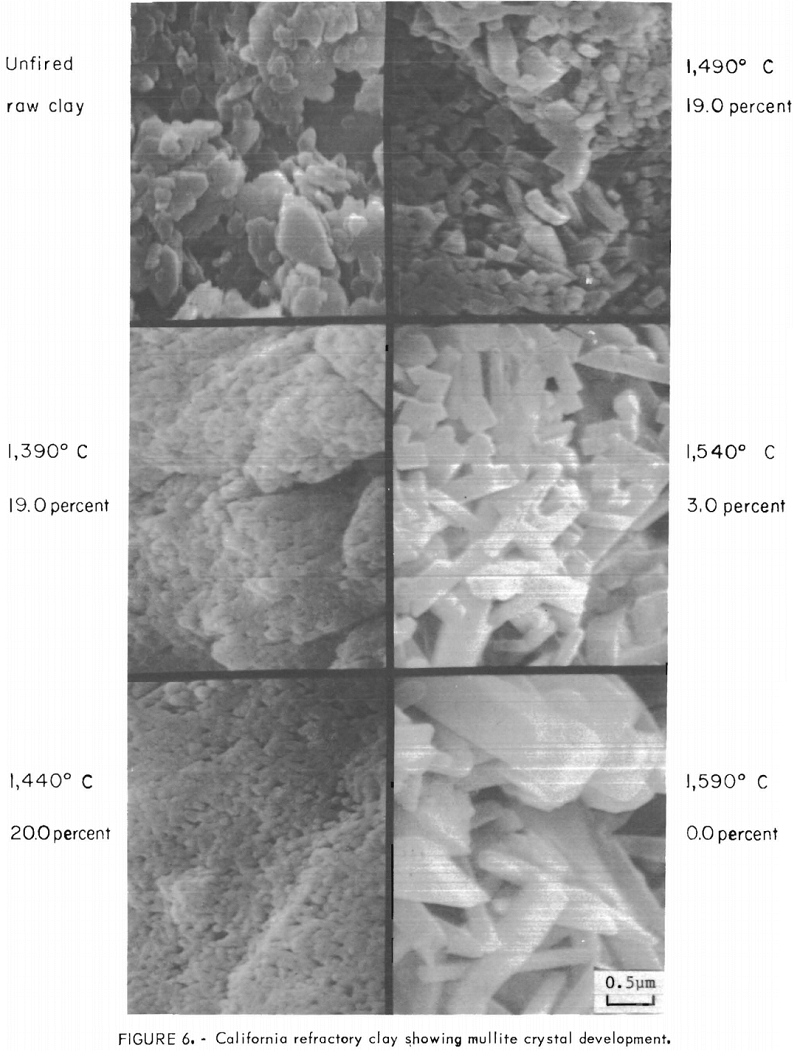
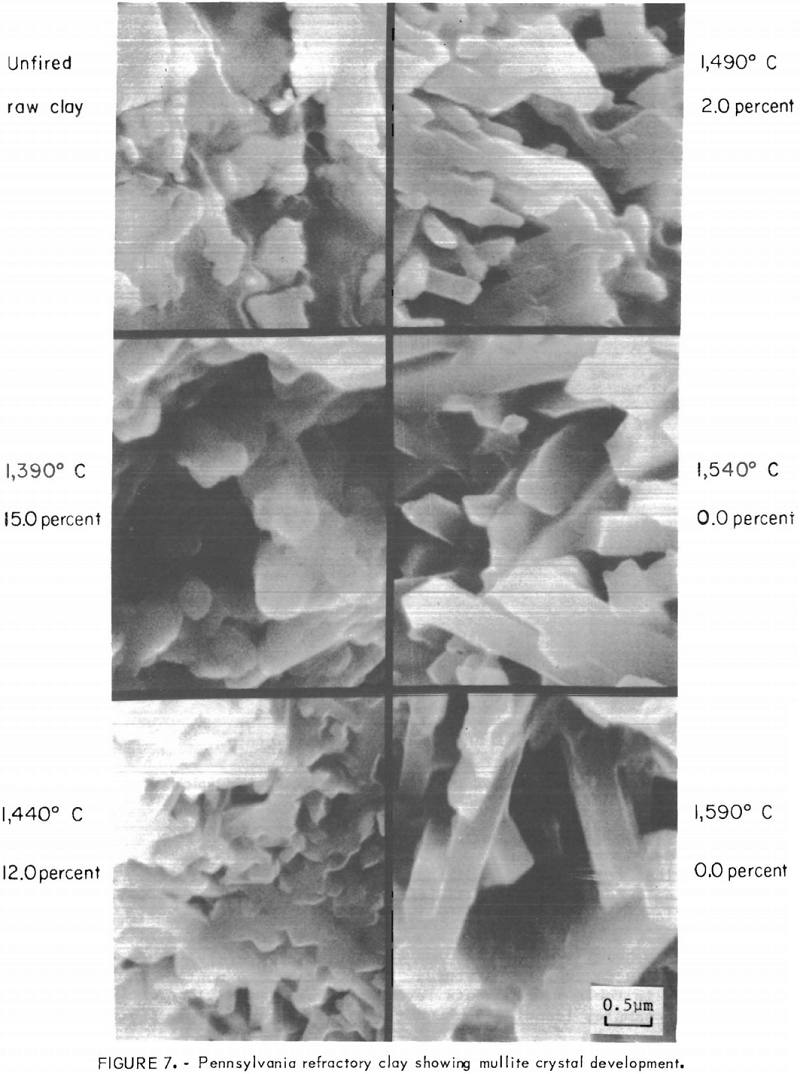
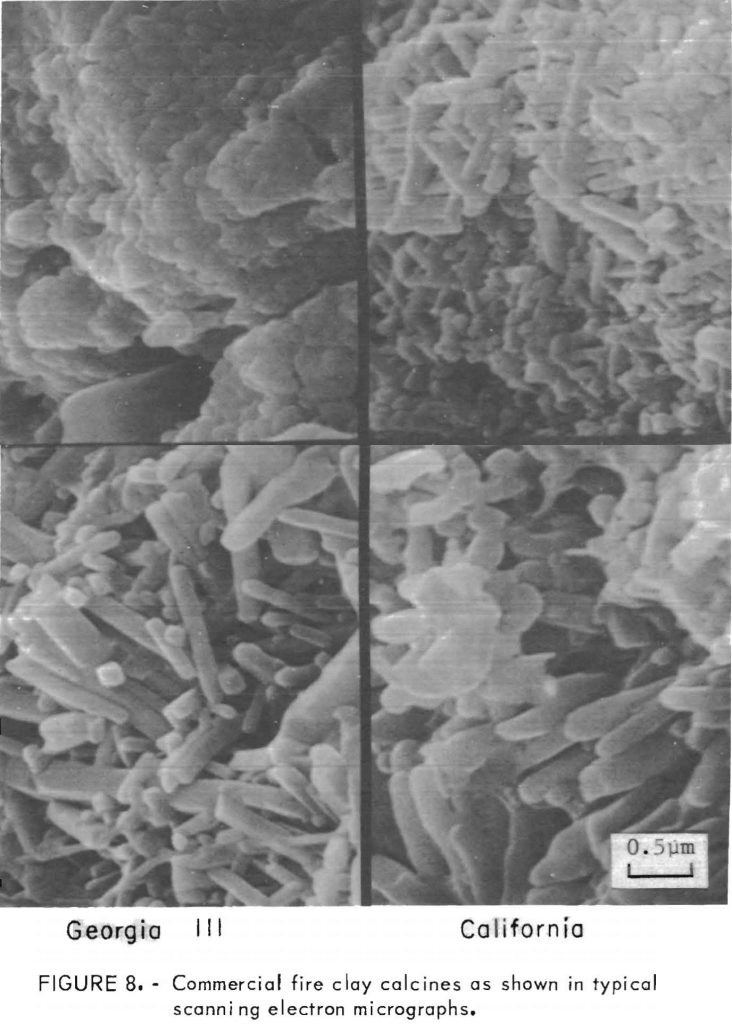
Effect of Heat Treatment on Cristobalite Formation
Cylindrical test specimens of each of the seven raw refractory clays were produced using a de-airing hydraulic extrusion press. Specimens were 7 inches long, with diameters of 0.5 inch. Dried samples were heated to temperatures of 1,390°, 1,440°, 1,490°, 1,540°, and 1,590° C within a period of 90 minutes at a controlled heating rate; held for 45 minutes at temperature; and cooled within 90 minutes to room temperature. The cristobalite content of the samples is given in table 4. The data reveal that at 1,390°, 1,440°, and 1,490° C, the samples identified as Georgia I, Alabama, Georgia II, Georgia III, and California had cristobalite contents between 16.5 and 21.0 percent,, At 1,540° and 1,590° C, the cristobalite content dropped to zero. The two clays from Missouri and Pennsylvania had lower amounts of cristobalite than the other five clays after calcination at 1,390°, 1,440°, and 1,490° C, averaging 15.5, 11.5, and 3.0 percent, respectively. For comparative purposes, the cristobalite content of each “as received” sample is also given in the table.

When the cristobalite content of each clay was plotted against calcination temperature (fig. 9), two groupings evolved. Five of the clays averaged 18 to 20 percent cristobalite from 1,390° to 1,500° C. When heated beyond 1,500° C, their cristobalite content decreased and was finally zero at 1,540° C. The fire clays from Missouri and Pennsylvania showed a gradual and continuous decrease in cristobalite content from 15 to 0 percent through the calcination range of 1,390° to 1,540° C. These two calcines have relatively high K2O contents of 0.56 and 0.62 percent, respectively, as shown in table 1. This may be the most likely cause for the development of lesser amounts of cristobalite at the various calcining temperatures.
Effect of Heat Cycling on Cristobalite Formation
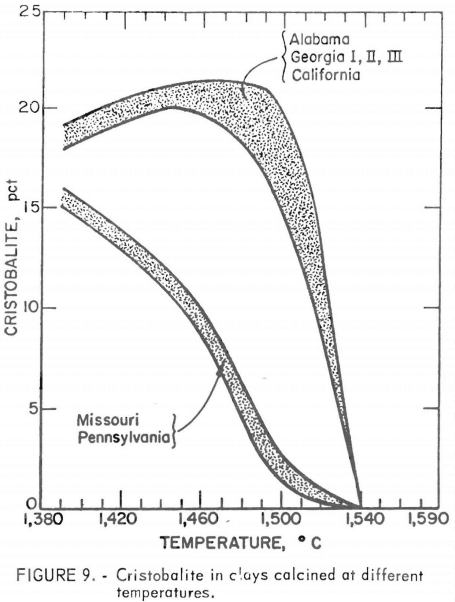 A fire clay calcine undergoes a second firing cycle when it is used to produce a refractory product and when the product is placed in service, it experiences many additional heating cycles. In order to study the formation of cristobalite in calcines under simulated service conditions, the samples that were calcined at 1,590° C (to insure that no cristobalite was present) were reheated a number of times to 1,440° C. The amount of cristobalite present in the reheated samples was determined after each firing cycle. The 1,440° C reheat cycles all followed a heating time of 90 minutes, a soak of 45 minutes, and a
A fire clay calcine undergoes a second firing cycle when it is used to produce a refractory product and when the product is placed in service, it experiences many additional heating cycles. In order to study the formation of cristobalite in calcines under simulated service conditions, the samples that were calcined at 1,590° C (to insure that no cristobalite was present) were reheated a number of times to 1,440° C. The amount of cristobalite present in the reheated samples was determined after each firing cycle. The 1,440° C reheat cycles all followed a heating time of 90 minutes, a soak of 45 minutes, and a
cooling time to room temperature of 90 minutes. The amount of cristobalite present in the reheated samples was determined after one, two, four, six, and eight cycles . Cristobalite reoccurred in all the samples after the first reheat cycle. After the fourth reheat cycle , the Alabama , California , and three Georgia calcines stabilized at a level of 15 to 18 percent cristobalite. The Missouri and Pennsylvania calcines, however, showed only about 4 percent cristobalite after the fourth reheat cycle and about 8 per cent after the sixth and eighth cycles.
Effect of Additives on Cristobalite Formation
Based on several references in the ceramics literature related to high-temperature reactions in kaolinites and the development of mullite and cristobalite, five different additives were chosen for a study of their effects on cristobalite formation in the seven refractory clays. The additives were aluminum sulfate (Al2(SO4)3), potassium carbonate (K2CO3), lithium carbonate (Li2CO3) , lithium chloride (LiCl) and lithium flouride (LiF). They were blended into the refractory clays in amounts varying between 0.2 and 2.0 weight-percent. The clays plus additives were calcined at 1,590° C and then reheated repeatedly to 1,440° C. The cristobalite content of each sample was determined after each heat treatment.
The results of the study indicated that lithium salts were effective in inhibiting the recrystallization of cristobalite after repeated reheating cycles. Aluminum sulfate and potassium carbonate did not appear to be effective, Table 5 shows typical effects of LiF additions on cristobalite formation, when using the Alabama and California clays. The optimum amounts of LiF required to prevent development of more than 1 percent cristobalite in each of the different clays after eight reheating cycles at 1,440° C are given in table 6.
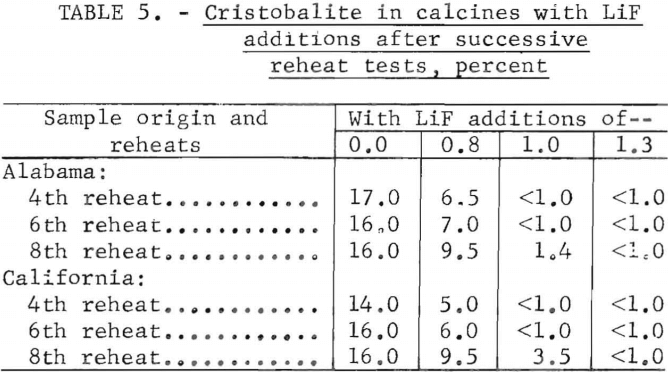
Note.—Clays were calcined at 1,590° C and reheated to 1,440° C.
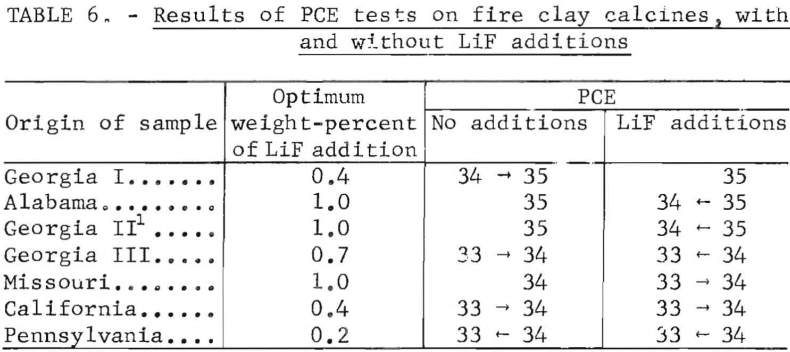
Note.—Arrows in the two PCE columns point to the cones closest to the determined PCE values.
Results of PCE determinations on fire clay calcines relative to these additions are also shown in table 6. The PCE determinations followed the ASTM procedure C24-72. The PCE values of calcines with LiF additions were less than a half cone lower than for calcines without additives, a decrease in refractoriness of about 10° C.
Conclusions
The formation of cristobalite in seven commercial and prepared calcines that were representative of fire clay calcines produced in different parts of the United States were studied and the following conclusions can be drawn regarding these materials:
- No cristobalite occurred in the fire clay samples at calcining temperatures of 1,540° and 1,590° C.
- At calcining temperatures from 1,390° to 1,490° C, 2 to 21.0 percent cristobalite occurred in the calcined materials.
- A progressive increase in mullite crystal size occurred through the calcining range of 1,390° to 1,590° C, for all clay samples.
- In cristobalite-free calcined fire clays produced at 1,590° C, cristobalite was recrystallized when these fire clays were reheated at 1,440° C.
- The natural occurrence of alkali in some calcined fire clays partially inhibited the formation of cristobalite.
- The addition of a lithium compound to a fire clay resulted in a calcined product in which cristobalite formation was almost completely eliminated. The addition of the lithium compound reduced the refractoriness of a calcined fire clay by less than one-half cone.
